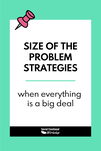Students can get stuck in a rut, overreacting to minor problems repeatedly. You've done the size of the problem lessons, but in the moment, students often have a hard time telling the difference between big deals and little deals.
When we talk about the size of a problem, we often need to look at what caused the student to misjudge it in the first place. Usually, at the root of thinking something is a big deal is a thinking mistake. Students have a negative thoughts about themselves or others or a situation. Negative feelings happen after that. Then, off we are to Meltdown Mountain.
For example, someone is whispering to a friend. Your student thinks they are talking about them. They assume everyone hates them, and they feel angry and sad. They pout, put their head down, and refuse to speak to anyone.
There are a couple of thinking mistakes at the beginning of this big reaction. We can help students understand the kind of missteps (i.e., automatic negative thoughts) they make so they can be better at judging the size of a problem and controlling the size of their reaction.
This post will cover typical thinking mistakes kids make, help students recognize them, and connect those too big (over)reactions.
Thinking Mistakes 101
Making thinking mistakes is part of being human. Here are 6 ways to talk about the kinds kids make.
Gloomy: Focusing on small negative things.
- You get a 90 on a spelling test and think: "So stupid! How did I miss it? It's such an easy word."
- Your friend compliments your new jacket, and you think: "She's always so nice. This jacket is so boring. She can't possibly really like it."
Hype: Making something into a big deal.
- You forgot to turn in your book report and think: "Now I'm going to fail. My teacher isn't going to let me turn it in late."
- You fight with your friend and think: "I'm not talking to him again. That's it!"
Omen: Predicting bad things will happen.
- You have a class party today, and you think: "It will probably get canceled because of our behavior with the substitute yesterday."
- Your teacher didn't call you when you raised your hand, and you think: "She thinks I don't know the answer, and I am going to waste everyone's time."
Fault: Blaming ourselves or someone else.
- You didn't turn your book report in, and you think: "My teacher should have reminded me."
- Your bike got a flat tire, and you think: "I probably ran over something sharp because I never pay attention. My mom should take away my bike."
Rule: Focusing on what should happen.
- Jeff gets extra time on his tests, and you think: "No fair! We should all get more time."
- Craig is reading at recess, and you think: "Craig should play with everyone else. I'm going to take his book so he can't read."
Heart: Only listening to feelings.
- You finished your art project and think: "It's embarrassing. It's not as good as Simone's. Hers are always the best."
- You have a solo at the concert and think: "I'm so nervous. Hopefully, no one walks out. I'm glad it's short."
Get Specific: My Thinking Mistakes
Kids often make one or two kinds of these, so it is helpful to focus on the ones that are personal to them.
For example, does your student get stuck on what should happen or what people should be doing (i.e., Rule Thoughts)? Or they could focus on little negative parts of a situation rather than seeing the big picture (Gloomy Thoughts).
You can write down examples of the kinds of negative thoughts and have the student sort them into thoughts that they relate to and thoughts they don't.
You could also take previous examples of their significant reactions and look at the thinking behind them. Then, determine what kind of mistakes they made.
The Mistakes Behind Big Reactions
If students know their thinking mistakes, they can better understand how or why their reactions got so big. Once you know them, develop strategies to challenge those thinking mistakes.
If I'm prone to Rule Thoughts, I might use self-talk to remind myself that it is not my job to police everybody.
Strategies like positive self-talk or three questions are great tools for students to practice.
This post has 9 positive thinking strategies students can use to challenge negative thinking.
Thinking mistakes can lead to big reactions. Students can learn the ones that they make, how to manage them, and then how to prevent big reactions before they start.
Are you looking to get started helping students challenge thinking mistakes? Check out the resources below and download your Negative Thinking Mistakes Poster.
Helpful Resources

Negative Thinking Activities
This resource will help you teach students about different kinds of negative thinking, how to recognize and challenge negative thinking, and how to use positive thinking.

CBT Activities Bundle
Hands-on and digital cognitive behavioral therapy CBT activities for kids to help them understand their feelings, thoughts, and actions.

















